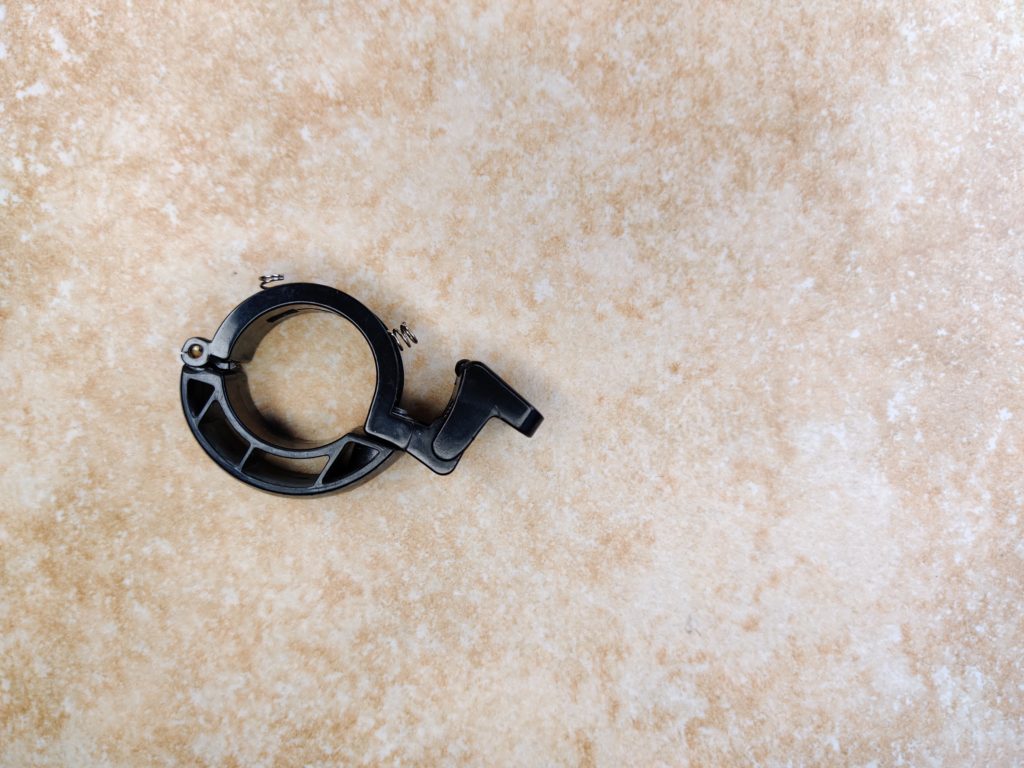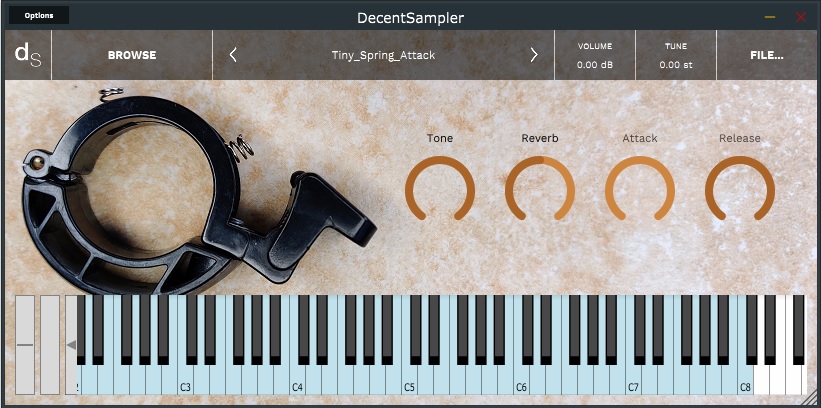
The story
You’ll never know when the inspiration will visit you. I’ve decided to create a Decent Sampler library the first ever time in my life after recording this spring and making a sample out of it for the cover song on my YouTube channel. In fact it’s a small spring from my bicycle bell which was broken last year and I was too lazy to fix it or to throw it away. While waiting the green traffic light I was pulling this spring with my finger. Once I’ve noticed that this tiny spring sound is rather musical so I’ve decided to turn it into a sample! Then a sample was turned into a sample library and here we are. I hope you’ll enjoy the result!
Shape of you cover (that's where idea of sampling came from)
A demo by my friend
Interface

Reviews for Tiny Spring
- Sound
- Character
- Playability
- Inspiration
- GUI
Leave a review to let others know what you thought of the instrument!
Yowza
It's tough sorting through sample libraries. One time you get "I went 19.000 miles to sample this Assyrian Bifurcated Whale Horn!" Then you hear... "doiinnk." (???)
Today it's "uh.. I like broke part of my bike and sampled it.." and WOW is right. Good ear and vision in picking up on this and nice work forming it into shape!Only a taster... I hope...
Wow!
I will say it again. Wow!
Okay, so you saw a photo of a plastic bracket for a bicycle bell, plus a simple Decent Sampler UI, and you immediately dismissed it as 'another of those 'silly found sounds'' and moved on to something more worthy of your time.
In doing that you ignored a gem. Or rather, the beginnings of a whole 'Crown Jewels'-worth of precious stones. I'm not kidding. I may be crazy sometimes, but I know gold when I hear it.
So what do you get? You get two samples, one a short sound that concentrates on capturing the 'Attack' sound of the tiny spring from a bicycle bell bracket, the other a less damped, longer, more sustain-focussed recording that is not as bright, and more moody. The basic sound is a bit like one of the upper bars on a marimba, but with less of the boomy, woody tone, and just a few hints of metallic overtones. Layer this with a marimba and you have one of those composite instruments where people wonder if it is a 'treated' marimba', or just a hyper-real marimba recording, or a marimba processed by a chain of guitar effects. There are any number of ways of working with this type of 'sweetener' or 'augmentation' sound, and you don't have to combine it with just a marimba either. Suffice it to say that this is a complex and very musical sound disguised as a piece of personal transport accessory miscellany.
There are three .dspresets in the sample pack. Two of them use the two samples on their own to give an Attack preset and a Sustain preset (which actually just lasts longer - it doesn't continuously sustain), but there is also a 'Combined' preset which uses both samples, and that gives a strange phasey, out-of-tune sound that is very peculiar indeed. I looked at the spectra of the two samples to try and figure out what was going on, but it needs more detailed analysis.
I give extra points for keyboard ranges which go low, and this does that with good results. Yes, I know that it just highlights the pitch shifting algorithms and their artefacts, but I like low frequencies. This virtual instrument also avoids going too high and hence veering into aliasing territory, which is also good in my book. (Some of my virtual instruments deliberately leave in some truly nasty aliasing and pitch-shifting artefacts, but this is because sometimes rough and dirty can be gold!)
The 'Tone' control provides low-pass filtering of the sounds, which just removes brightness in this case, and I would have gone for a much more resonant filter myself to give more control over timbre. But this would have taken the sound away from realistic and into more synthetic places, and this would be out of context with the intention of this sample pack. The Reverb uses the default 0.7 room size, and I would have liked to be able to vary that, but as it is, you only get a control over the reverb wet level. What is very welcome are the envelope controls: Attack and Release, so that you can remove the attack of the 'Attack' sample, and shorten the release of both samples so that you get a kind of reverse effect. As you are probably already predicting, I would like full ADSR envelope control...
And this is where it gets interesting. I had a play with the .dspreset, adding loops and increasing the release time (which was fun and good for complex polyrhythms), but it was only when I started processing the two samples that the blinkers were lifted from my eyes (or ears, actually). There's a whole sonic universe inside these two samples, and I wasn't being flippant when I hinted in the title that what you have here is potentially just volume 1... or maybe just a teaser. Maybe it is me and my love of finding sounds inside sounds via various processing techniques, but I found some really nice timbres... I would be very interested in either collaborating or getting permission to use the samples, so if Max would like to contact me... (martin.russ@owasp.org) (I'm still not sure if publishing to Pianobook.co.uk gives implicit permission for people to edit/process/use the samples inside the sample packs and then re-publish variants, so I always ask, and few people respond!)
Overall then, an overlooked masterpiece that just about everyone is going to dismiss as 'just another bit of metallic sound sampling, with a ridiculously over-the-top review by an obviously deranged mad person.' I disagree. There's a lot of ways that you can use the sounds in this version, but if you are willing to delve inside the samples, then there's some precious stuff inside. A very pleasant surprise, and I can't understand why this is the first review!
W o w !
(You can stop shaking your head in pity at my insane ravings now...)
Great Instrument!
great simple instrument that could come in helpful, the video was great too lol
A "cold", resonant mallet
This is a fairly simple instrument, featuring a percussive mallet, with a very prominent, metallic, "cold" attack and a very resonant body. Personally this kind of sound reminds me something "christmas" based, though you might relate it to something totally different. It is very responsive, and it is bound to play across 6 octaves, though the lower ones sound overly stretched when compared to the far better defined mid and high ranges. Max was kind enough to include all the core settings that, even if these are not really common for mallet-type instruments.




